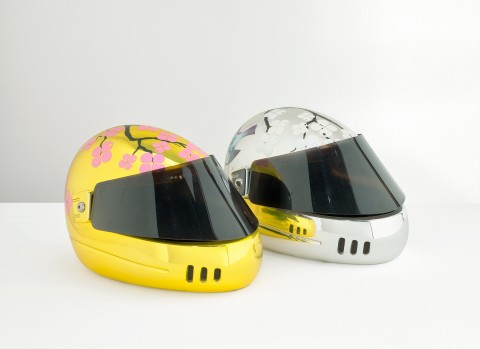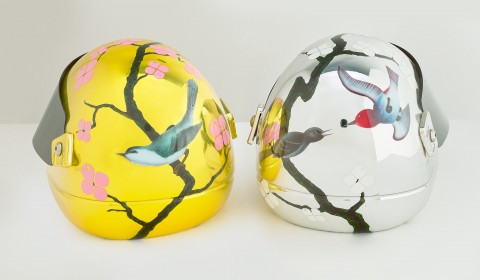PINK SPRING, WHITE SPRING, 2003
PATRICIA PICCININI
(FROM THE 'PRECAUTIONS' SERIES)
fibreglass, polycarbonate and automotive paint
17.0 x 17.5 x 23.5 cm (each)
Tolarno Galleries, Melbourne
Joan Clemenger AO and Peter Clemenger AO, Melbourne, acquired from the above in 2003
Precautionary Tales, Tolarno Galleries, Melbourne, 6 September – 28 October 2003, cat. 1 and cat. 2
Patricia Piccinini’s celebrated photographic and sculptural practice has long grappled with profound questions of what it means to be human and fragile in an age of rapid technological and radical biological innovation. Her works play out scenes of family dynamics in photographic and sculptural tableaux populated by lifelike fleshy beings in silicon or hard-edged, highly polished automotive hybrids. The artist deftly moves between the elements of the ‘biosphere’ and what Linda Michaels labelled the ‘autosphere.’1
Pink Spring, White Spring, 2003 – a pair of gleaming motorcycle helmets of silver and gold, beautifully decorated with stylised sakura blossoms and chirping birds – have been built to accommodate the unusually distended physiognomy of a small and tender head. As suggested within her iconic 2003 Venice Biennale presentation representing Australia, the voids within these helmets hint at unfamiliar and radically different beings in her world, their wide-eyed and pudgy fragility requiring uniquely crafted protective armour.
Around 2002, Piccinini began a series of anthropomorphised sculptural figures and wall-mounted tiles derived from engine and chassis parts of automotive vehicles. Their rounded and streamlined forms were sumptuously detailed with surface gloss and some were also airbrushed decals of flowers, flames and skulls. Presented as desirable consumer items on a shelf and decorated with stylised kawaii designs, Piccinini’s helmets also comment on the accelerated consumer culture she had experienced in Japan while studying there on a grant in 1998.
A leitmotif throughout her practice, the form of the helmet implies the presence of the most powerful and precious part of the body, which it must protect but also hide from view. Deeply inscribed in the zeitgeist of early 2000s tech innovation, Piccinini’s works have appropriated across disciplines, drawing from new technologies such as computer modelling of aerodynamic engineering and performance optimisation and applying these to imagined bio-technologically enhanced beings. By tampering with the standardised shape of a human helmet, distending, inflating and agglomerating it into atypical profiles, the imagined owner of this helmet is transformed into something that is neither human nor machine, the contours nevertheless streamlined and optimised for speed and protection.
1. Michael, L., ‘Patricia Piccinini’ in Museum of Contemporary Art Handbook at https://www.mca.com.au/collection/artists/patricia-piccinini/ (accessed October 2024)
LUCIE REEVES-SMITH

